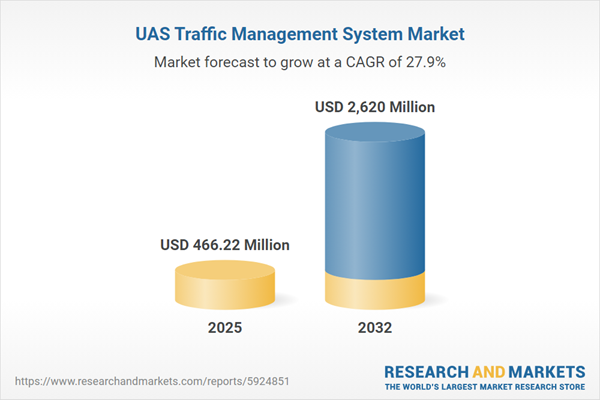Speak directly to the analyst to clarify any post sales queries you may have.
The UAS Traffic Management System Market is undergoing rapid transformation as organizations prioritize secure drone integration and resilient airspace management. Senior leaders are focusing on regulatory readiness, operational agility, and technology adoption to navigate complex unmanned aerial systems environments effectively.
Market Snapshot: UAS Traffic Management System Market Size and Growth
The UAS Traffic Management System Market is valued at USD 365.79 million in 2024 and is expected to reach USD 2.62 billion by 2032, representing a CAGR of 27.93%. Growth is fueled by advancements in digital infrastructure, the adoption of automation, and the diversification of drone use across commercial, government, and civil sectors. Organizations seek to optimize managed airspace access, strengthen compliance, and streamline operations using advanced management solutions. With increased drone activity, key stakeholders are focusing on standardizing airspace coordination and integrating data analytics, further driving expansion and accelerating innovation in this dynamic market.
Scope & Segmentation: UAS Traffic Management System Market
This report delivers practical insights for executives aiming to make informed investment and competitive decisions. It details segmentation and highlights how technology and regional trends shape stakeholder priorities:
- Component: Hardware solutions deliver operational reliability for ongoing activity. Software platforms are central to automation, analytics, and real-time management. Specialist service providers contribute to seamless deployment and continuity in diverse scenarios.
- Application: Agriculture leverages drones for efficient crop management, while logistics deploys drone fleets for improved routing and urgent deliveries. Infrastructure, utilities, and networks use drone-enabled inspections for rapid assessment and oversight. Media, mapping entities, and public safety agencies utilize these systems for agile data gathering and response coordination.
- End User: Civil organizations emphasize flexible regulatory adaptation and airspace safety. Commercial users focus on workflow optimization and fast response capabilities. Public entities, including defense and emergency services, center on secure operations tailored to mission objectives.
- Connectivity: Cellular (4G LTE, 5G) networks underpin large-scale, data-driven deployments, particularly in dense urban areas. Satellite connectivity (GEO, LEO, MEO) expands coverage for remote applications. Wi-Fi serves localized missions or those requiring privacy controls.
- Platform: Fixed-wing, rotary-wing, and VTOL drones enable tailored payloads and mission flexibility. This versatility ensures compliance with regulatory distinctions and supports a wide array of use cases.
- Regions: Market adoption patterns reflect distinct compliance frameworks, infrastructure levels, and investments in the Americas, Europe, Middle East & Africa, and Asia-Pacific, with customized operational approaches in each geography.
- Companies: L3Harris Technologies, Honeywell, Airbus, Leonardo S.p.A., Frequentis AG, Thales, Lockheed Martin, Verizon, Unifly, and Boeing lead in innovation, shaping best practices and technological standards.
Key Takeaways for Senior Decision-Makers
- Integrated UAS traffic management enhances coordination between drones and manned aircraft, minimizing uncertainty and promoting airspace safety for all operators.
- Modular design in management systems enables adaptation to evolving regulations and industry-specific needs across diverse high-value sectors.
- Standardization initiatives support smoother international drone operations, helping organizations maintain consistency with updated compliance expectations.
- Advanced analytics and artificial intelligence deliver real-time situational awareness, empowering leaders to oversee fleet performance and manage operational risks proactively.
- Collaboration among aerospace, telecom, and IT providers delivers platforms that rapidly adapt to new regulatory and operational requirements within complex airspace domains.
- Regionalized implementation strategies help organizations maintain resilience and compliance across various infrastructure levels and governance approaches.
Tariff Impact: Navigating Supply Chain and Cost Dynamics
Organizations in the UAS Traffic Management System Market are reassessing supply chain strategies in response to upcoming U.S. tariffs. Many are moving toward nearshoring and modular manufacturing models to reduce disruption risks and maintain reliable product delivery. This proactive stance supports continuity and aids in counteracting emerging cost challenges, facilitating ongoing access to critical assets as global tariff dynamics evolve.
Methodology & Data Sources
The report's findings are built on extensive interviews with regulatory officials, technical stakeholders, and UAS professionals, supplemented by technical documentation review and proprietary industry modeling. This approach ensures high-quality, actionable intelligence tailored for executive decision-making and forward-looking planning.
Why This Report Matters
- Aligns leadership teams on the latest strategies for implementing UAS traffic management systems in sync with current and emerging regulatory requirements.
- Prepares organizations to scale drone deployments efficiently—while controlling operational complexity and meeting increased oversight.
- Enhances supply chain resilience and competitiveness, enabling organizations to adapt to rapid technological and policy shifts.
Conclusion
Adopting adaptive, data-driven UAS traffic management prepares organizations for evolving airspace, regulatory, and operational landscapes. These solutions lay the foundation for responsive, compliant, and sustainable growth in drone-enabled enterprises.
Additional Product Information:
- Purchase of this report includes 1 year online access with quarterly updates.
- This report can be updated on request. Please contact our Customer Experience team using the Ask a Question widget on our website.
Table of Contents
3. Executive Summary
4. Market Overview
7. Cumulative Impact of Artificial Intelligence 2025
Companies Mentioned
The companies profiled in this UAS Traffic Management System market report include:- L3Harris Technologies, Inc.
- Honeywell International Inc.
- Airbus SE
- Leonardo S.p.A.
- Frequentis AG
- Thales S.A.
- Lockheed Martin Corporation
- Verizon Communications Inc.
- Unifly N.V.
- The Boeing Company
Table Information
| Report Attribute | Details |
|---|---|
| No. of Pages | 182 |
| Published | October 2025 |
| Forecast Period | 2025 - 2032 |
| Estimated Market Value ( USD | $ 466.22 Million |
| Forecasted Market Value ( USD | $ 2620 Million |
| Compound Annual Growth Rate | 27.9% |
| Regions Covered | Global |
| No. of Companies Mentioned | 11 |









